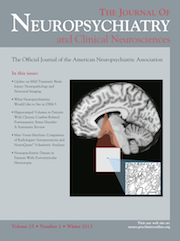Quetiapine-Associated Pathological Stealing in An Adolescent Girl
To the Editors: “Miss H,” a 17-year-old girl, did not have history of mood disorders, conduct problems, substance misuse, or physical illness. She was diagnosed with schizophrenia at age 16, with initial presentations of persecutory delusion and formal thought disorder. She received comprehensive physical examinations, and organic etiology was excluded. Because of aggravated psychotic symptoms, she was admitted for 1 week. Her psychosis was controlled under quetiapine 600 mg/day. However, 1 month after her discharge, her disorganized speech and referential delusion relapsed. Quetiapine was hence increased to 800 mg/day. The delusions and formal thought disorder subsided gradually; unexpectedly, pathological stealing developed. Miss H stole clothes and stationery in stores and school 3–4 times per week. She alleged that she did not plan before the stealing, but she could not control the impulse of grasping. She did not act under delusion, hallucination, or somatic passivity. Concurrent medication only included estazolam 1–2 mg/day. Because the severity of pathological stealing was not consistent with her psychotic symptoms, quetiapine-associated pathological stealing was suspected. When we tapered quetiapine to 400–600 mg/day, the stealing behavior reduced to once in 2 weeks, but psychosis was aggravated. For better control of the disease, we switched to amisulpiride 400 mg/day. Her psychotic symptoms resolved 2 weeks later, and the stealing behavior appeared no more.
This is the first report on quetiapine-associated pathological stealing. In Miss H’s case, the pathological stealing was more likely to be related with the dosage of quetiapine, rather than the psychopathology of schizophrenia, since the onset of stealing behavior was inconsistent with concurrent psychotic symptoms and resolved only when quetiapine was tapered.
Several mechanisms might explain the pathological stealing associated with quetiapine use, such as disinhibition and compulsion. Disinhibition-associated pathological stealing is often caused by frontal lobe impairment.1 Central nervous system depressants might inhibit frontal lobe function and induce disinhibition. Also, the obsessive-compulsive (OC) symptoms may improve or worsen under atypical antipsychotics use.2 OC symptoms induced by clozapine are commoner than those from quetiapine. The mechanism involves 5-HT2A blockade of the atypical antipsychotics in the basal ganglia and orbitofrontal cortex.2,3 However, the role of younger age in this phenomenon is not clear.
Although we cannot directly demonstrate the causal relationship between quetiapine use and pathological stealing, the chronological sequence highly suggests this association. Clinicians should be cautious about it and its legal consequences, especially for adolescents. Careful differential diagnosis, tapering, or discontinuing quetiapine use was necessary.
1 : Pathological stealing in dementia: poor response to SSRI medications. J Clin Psychiatry 2011; 72:418–419Crossref, Medline, Google Scholar
2 : The paradox of quetiapine in obsessive-compulsive disorder. CNS Spectr 2005; 10:356–361Crossref, Medline, Google Scholar
3 : Synergistic action of 5-HT2A antagonists and selective serotonin reuptake inhibitors in neuropsychiatric disorders. Neuropsychopharmacology 2003; 28:402–412Crossref, Medline, Google Scholar



